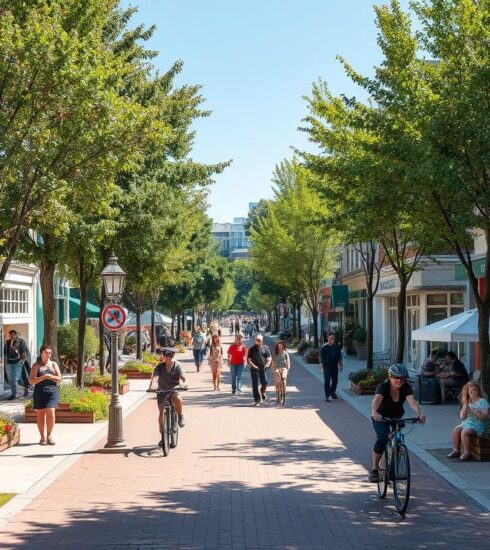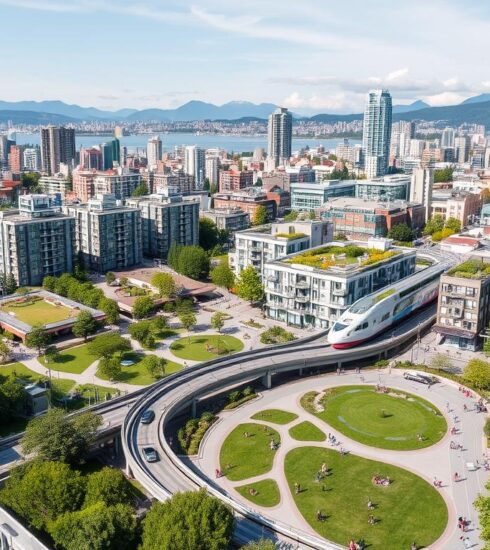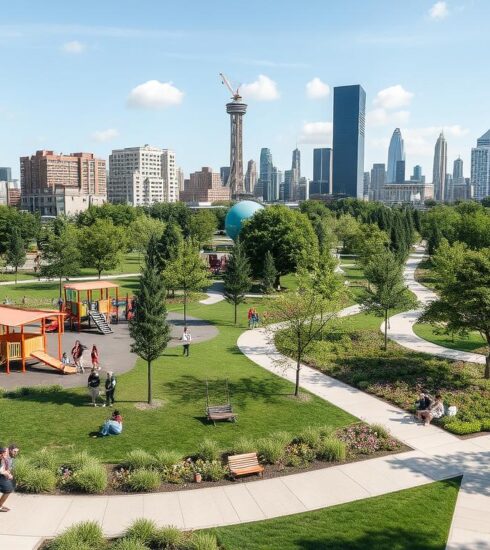The Green City Blueprint: Vancouver’s Innovative Approach to Sustainability in Urban Design
- Jackie De Burca
- November 20, 2024
Vancouver stands at the forefront of1 sustainable urban development, implementing innovative solutions to address environmental challenges. The city’s approach encompasses green infrastructure, sustainable transportation, and community engagement. With projected population growth of over a million new residents in the coming decade, Vancouver is reimagining its regional transportation and urban design to create an affordable and sustainable landscape1. The city’s commitment to sustainability is evident in its historical context, where TransLink’s network follows historic routes, showcasing the evolution from humble beginnings to a leader in urban innovation2.
Key Takeaways
- Vancouver is at the forefront of sustainable urban development, implementing innovative solutions to address environmental challenges.
- The city’s approach encompasses green infrastructure, sustainable transportation, and community engagement.
- Vancouver is reimagining its regional transportation and urban design to create an affordable and sustainable landscape.
- The city’s commitment to sustainability is evident in its historical context, with TransLink’s network following historic routes.
- Vancouver is leading the way in urban innovation, showcasing its evolution from humble beginnings to a global leader in sustainability.
Introduction to Vancouver's Urban Design Philosophy
Vancouver’s urban design philosophy is deeply rooted in the pursuit of sustainability, recognising the pressing need to address environmental challenges while accommodating the city’s rapid urban growth. This approach goes beyond simply reducing pollution; it emphasises the integration of smart technologies to create a more sustainable future for the city3.
The Importance of Sustainability
Sustainability is at the heart of Vancouver’s urban design philosophy. The city’s vision is to create a vibrant, liveable metropolis that coexists harmoniously with the natural environment, ensuring a viable future for generations to come4.
Historical Context
Vancouver’s historical context has played a significant role in shaping its current urban design. The city’s transportation network, embodied by the TransLink system, traces along historic routes, reflecting the evolution of Vancouver from its early days to its present status as a leader in urban innovation. This historical foundation has provided a solid basis for the city’s sustainable development initiatives4.
| Feature | Details |
|---|---|
| Area | 60,600 m23 |
| Project Year | 20203 |
| Building Certification | LEED Platinum3 |
| Design Approach | A new urbanist podium coupled with a slender tower3 |
| Role in Vancouver’s Urban Policy | Vancouver House is part of a new phase in Vancouver’s urban policy3 |
| Significance | Vancouver House is a model for approaching urban design3 |
| Functionality |

“Vancouverism” is a unique urban design philosophy characterized by tall, slender towers spaced out with low-rise buildings, green spaces, and pedestrian-friendly streetscapes4.
Overview of Vancouver's Environmental Initiatives
Vancouver has firmly established itself as a leader in sustainable urban development, implementing a comprehensive range of environmental initiatives to drive its vision of a greener and more liveable city. The city’s approach to sustainability is multi-faceted, encompassing key policy frameworks, innovative community engagement strategies, and a steadfast commitment to addressing pressing environmental challenges.
Key Policy Frameworks
At the heart of Vancouver’s environmental efforts are its robust policy frameworks. The city has scored 78/100 on the Walkscore ranking, making it the most walkable large city in Canada5. However, 8 out of 22 neighbourhoods in Vancouver have Walk Scores below 70, indicating the need for further improvements in walkability5. The Greenest City Action Plan and the Healthy City Strategy serve as the city’s guiding documents, integrating biodiversity and toxins reduction strategies to increase biodiversity levels and reduce toxins5. These policies are designed to address a range of environmental priorities, from climate change adaptation to resource conservation and sustainable transportation.
Community Engagement Strategies
A hallmark of Vancouver’s sustainable development approach is its emphasis on community engagement. In 2016, the city saw 159 block parties, with applications for such events steadily increasing since 20115. The city’s review of active living design practices from other jurisdictions aims to enhance physical activity opportunities in the built environment5, while initiatives like the Healthy City Strategy focus on improving walking access for under-served residents5. The development of temporary and permanent public spaces throughout the city further contributes to creating more active and vibrant community areas5. These community-driven sustainability efforts ensure that residents are actively involved in shaping the city’s green future.
Vancouver’s comprehensive environmental initiatives, supported by robust policy frameworks and community engagement, demonstrate its commitment to addressing the challenges of climate change, resource scarcity, and rapid urbanisation. By fostering a culture of sustainability and empowering its residents, the city is paving the way for a more sustainable and resilient urban future.

Green Infrastructure in Urban Design
Vancouver’s embrace of green infrastructure is a cornerstone of its sustainable urban design. The city has pioneered innovative solutions like green roofs, which serve multiple purposes – from reducing the urban heat island effect6 to improving air quality6 and providing habitat for urban wildlife7.
Examples of Green Roofs
Green roofs, which are roofs partially or completely covered with vegetation, have become increasingly popular in Vancouver. These living roofs not only enhance the aesthetic appeal of buildings but also contribute to significant energy savings, reducing cooling demands by up to 75% during the summer months6. The city’s green roof initiatives have inspired other urban centres to follow suit, showcasing the power of eco-friendly infrastructure.
Urban Forests and Biodiversity
Vancouver’s urban forests play a crucial role in the city’s biodiversity strategy. These natural air filters and recreational spaces contribute to a healthier, more resilient urban environment. Research indicates that integrating tree canopies and urban forests can reduce the urban heat island effect by up to 3.6°F compared to areas with minimal green cover6. Moreover, access to these green spaces has been associated with a 12% reduction in reported mental health issues among residents6. By preserving and expanding its urban forests, Vancouver is setting an example for other cities on the harmonious coexistence of nature and development.
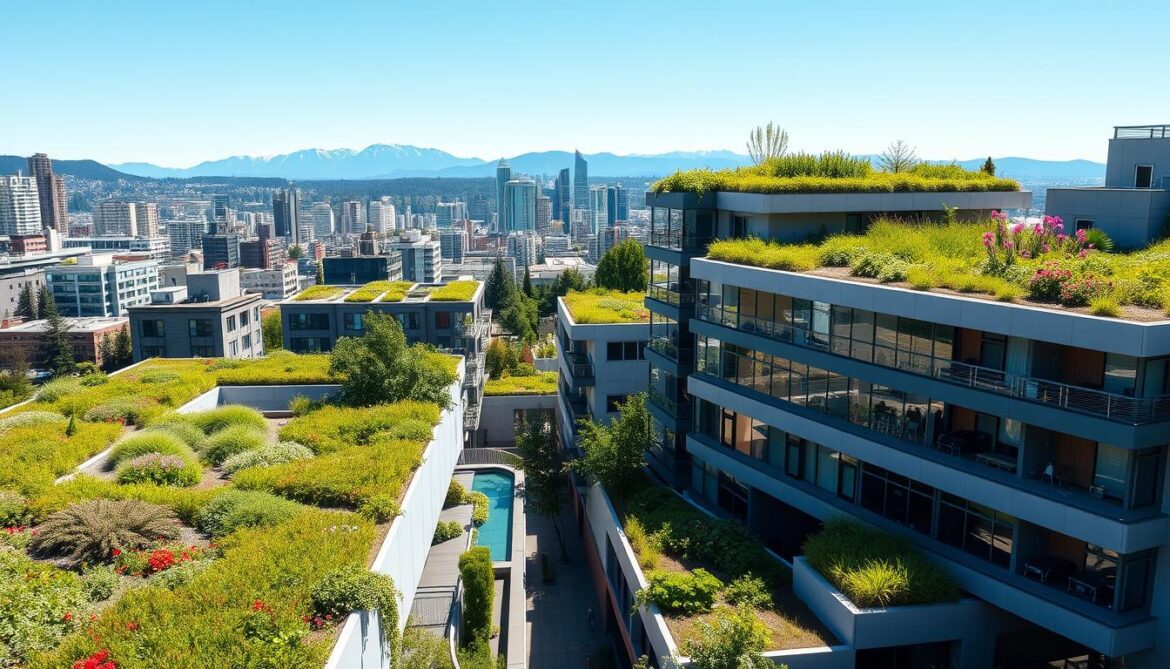
Vancouver’s approach to green infrastructure demonstrates how nature can thrive within an intensely developed urban centre, drawing inspiration from Singapore’s “City in a Garden” concept7. These initiatives not only enhance the city’s aesthetic appeal but also contribute significantly to its environmental resilience, showcasing the potential of eco-friendly infrastructure.
Sustainable Transportation Solutions
Vancouver is at the forefront of implementing sustainable transportation solutions to reduce carbon emissions and improve urban mobility8. The city’s Transportation 2040 plan is a long-term strategic vision guiding transportation and land use decisions with public investments8. This plan includes specific actions and policies to achieve long-term targets in an inclusive, healthy, prosperous, and liveable city8.
Public Transit Innovations
TransLink, Vancouver’s transportation network, is continuously innovating to meet the needs of a growing population while minimising environmental impact8. The Congestion Management Strategy, adopted in 2017, provides guidance on monitoring congestion, developing strategies, and tracking progress8. The annual transportation summer survey conducted in 2021 by the Mustel Group involved surveying Vancouver residents on travel pattern changes8. Monitoring and evaluation are integral to understanding progress towards transportation goals and making necessary adjustments based on trends and results8.
Cycling Infrastructure Developments
Vancouver’s cycling infrastructure is particularly noteworthy, with an extensive network of bike lanes and bike-sharing programmes encouraging residents to choose eco-friendly modes of transport8. The Active Transportation Promotion and Enabling Plan aims to increase the number of people walking and cycling through non-infrastructure-based approaches8. The transportation panel surveys from 2013 to 2021 provide insights into transportation trends, mode share goals, and progress towards sustainability8.
These initiatives not only reduce traffic congestion but also contribute to cleaner air and a healthier urban environment8. The Transportation 2040 Plan was approved by Vancouver City Council in 2012 after extensive consultation with over 18,000 citizens8. The plan emphasizes working with partners on projects of regional significance and engaging citizens to foster constructive dialogue8.
Vancouver’s transportation network connects to neighboring municipalities through road bridges, rail links, and ferry services, contributing to regional transportation plans8. The city’s sustainable transportation solutions have been recognized globally, contributing to its status as one of the most livable cities in the world9.
| Sustainable Transportation Initiatives | Key Achievements |
|---|---|
| Transportation 2040 Plan | Long-term strategic vision for sustainable transportation, approved by City Council in 2012 after extensive public consultation. |
| Congestion Management Strategy | Provides guidance on monitoring congestion, developing strategies, and tracking progress, adopted in 2017. |
| Active Transportation Promotion and Enabling Plan | Aims to increase the number of people walking and cycling through non-infrastructure-based approaches. |
| Bike Lanes and Bike-sharing Programmes | Extensive cycling infrastructure encouraging eco-friendly mobility. |

“Vancouver’s transportation network connects to neighboring municipalities through road bridges, rail links, and ferry services, contributing to regional transportation plans.”
Water Conservation and Management Strategies
Vancouver has implemented comprehensive strategies to ensure the sustainable management of its precious water resources10. The city has embraced innovative technologies like rainwater harvesting systems, which can reduce household water consumption by up to 50%10. These systems collect and store rainwater for non-potable uses, lessening the strain on the municipal water supply.
Rainwater Harvesting Systems
Rainwater harvesting has become a key component of Vancouver’s water conservation efforts10. By diverting rainwater from rooftops and other impervious surfaces, these systems provide a reliable source of water for tasks such as landscape irrigation, vehicle washing, and toilet flushing. This approach not only reduces the demand on the city’s drinking water but also helps mitigate the risk of urban flooding during heavy rainfall events.
Sustainable Drainage Solutions
In addition to rainwater harvesting, Vancouver has invested in sustainable drainage solutions to manage stormwater runoff10. Permeable pavements and bioswales, for example, allow water to infiltrate the ground, reducing the volume of water entering the sewer system10. These nature-based solutions also help recharge groundwater supplies and prevent localized flooding. Furthermore, the restoration and protection of natural water bodies, such as streams and wetlands, have been prioritized to enhance the city’s resilience to climate change and ensure the long-term availability of water resources.
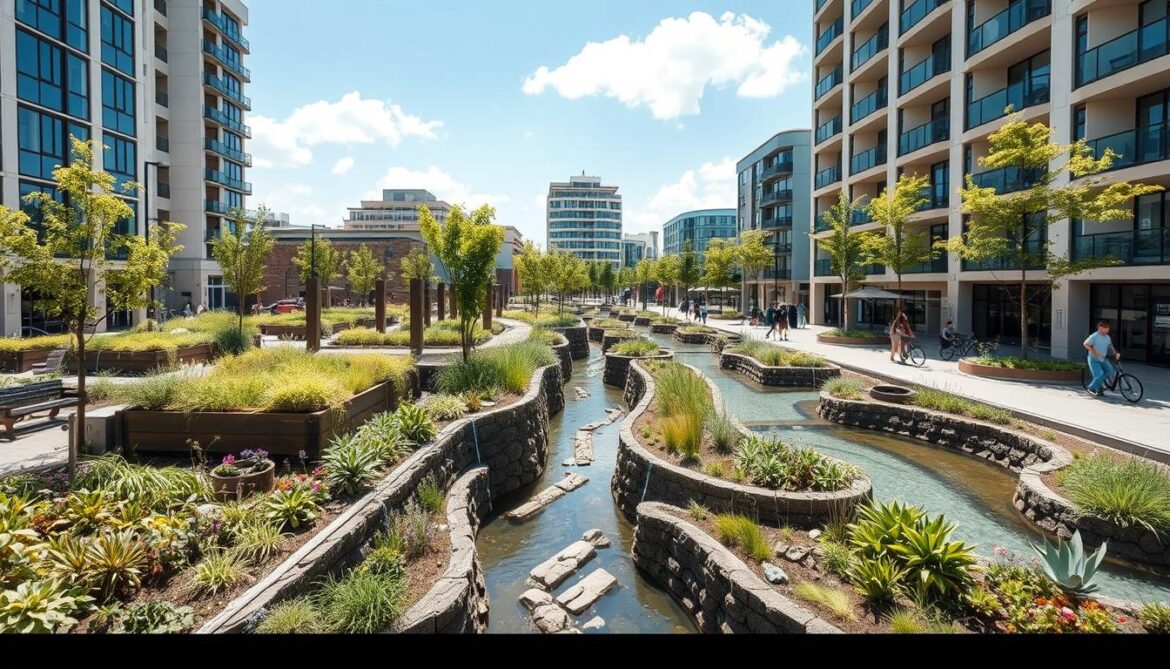
Vancouver’s comprehensive water conservation and management strategies demonstrate the city’s commitment to responsible resource stewardship and environmental sustainability11. By embracing innovative technologies and nature-based solutions, Vancouver is leading the way in urban water management, ensuring a more resilient and livable future for its residents11.
“Sustainable urban planning practices contribute to improved quality of life by reducing air pollution, leading to lower rates of respiratory illnesses and better public health outcomes.”11
| Water Conservation Strategies | Potential Water Savings |
|---|---|
| Rainwater Harvesting Systems | Up to 50% reduction in household water consumption10 |
| Xeriscaping | 50-75% decrease in water usage for landscaping compared to traditional methods10 |
| Smart Irrigation Technologies | Around 20-40% water savings in urban areas10 |
| Water-wise Workshops and Conservation Challenges | 15-20% decrease in community water usage10 |
| Water-efficient Appliances | 30% reduction in household water consumption10 |
| Greywater Recycling Systems | 25-40% savings in freshwater used for non-potable purposes10 |
| Large Liners for Water Bodies | Up to 90% prevention of water loss due to seepage10 |
These innovative strategies, combined with a strong emphasis on community engagement and public education, have positioned Vancouver as a leader in urban water management and sustainable drainage solutions11. By taking a comprehensive approach to water conservation, the city is ensuring a more resilient and environmentally responsible future for its residents11.
Energy Efficiency in Urban Planning
Vancouver’s urban planning prioritises energy efficiency as a crucial component of its sustainable development strategy12. The city’s commitment to energy efficiency extends to retrofitting existing buildings, showcasing a comprehensive approach to reducing urban energy consumption and carbon emissions12.
Net-Zero Energy Buildings
Renewable Energy Integration
The city is also focusing on integrating renewable energy sources into its urban fabric, with initiatives to increase solar panel installations and explore geothermal energy potential1213. Vancouver’s electricity generation mix in 2018 was dominated by hydropower (91%), with natural gas (6%), petroleum (2%), and a small contribution from biomass, geothermal, wind, and solar (3.
Vancouver’s commitment to energy efficiency and renewable energy integration has earned it recognition as one of the greenest international cities in the world13. The city’s initiatives and policies demonstrate a comprehensive approach to reducing urban energy consumption and carbon emissions, making it a leader in sustainable urban planning12.

“Vancouver is consistently ranked among the greenest international cities in the world.”13
The Role of Community in Sustainable Design
Vancouver recognises the critical role of community involvement in creating sustainable urban spaces. The city regularly organises public workshops and conducts surveys to gather input from residents on urban design projects14. These participatory processes ensure that sustainable initiatives align with community needs and values14.
Collaborative design processes bring together diverse stakeholders, including residents, urban planners, and environmental experts, to co-create solutions for urban challenges. This approach not only enhances the effectiveness of sustainable design initiatives but also fosters a sense of ownership and pride among Vancouver’s residents, contributing to the long-term success of the city’s sustainability efforts14.
Public Workshops and Surveys
Vancouver’s innovative approach to sustainability in urban design involves transforming a 536-acre site in Edmonton into one of the world’s most sustainable communities, accommodating up to 30,000 residents over the next 20 years14. In May 2022, students from the Urban Systems 530 class visited Edmonton to propose practical and cost-effective innovations supporting Blatchford’s environmental, social, and economic goals14.
Collaborative Design Processes
The four students involved in developing proposals used a value engineering approach to evaluate innovative ideas based on innovation, fulfillment of objectives, return on investment, ease of construction, stakeholder acceptance, sustainability, and life-cycle cost criteria14. Dividing Blatchford into 12 superblocks or “five-minute cities” was proposed, emphasizing the importance of having all essential services within a 15-minute walk or bike ride for residents14.
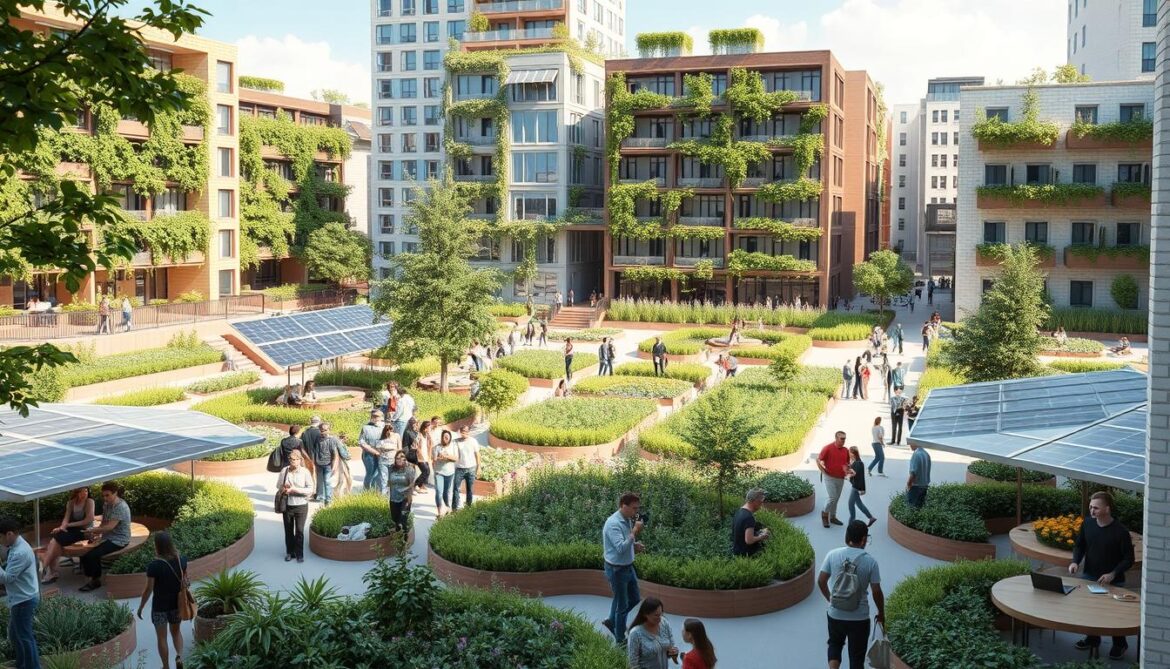
Recommendations included a smart parking system, smart meters for energy usage monitoring, residential coworking spaces, and a community ridesharing app to enhance sustainability in Blatchford14. Introducing geothermal piles in new construction for medium- and high-rise buildings was suggested to align with Blatchford’s vision of a carbon-neutral, renewable-energy-powered neighbourhood14.
Implementing new materials in road construction, such as nano-sized acrylic copolymers and plastic waste in bituminous surfaces, to improve road durability and lifespan14. The sustainability concepts proposed by the students were positively received by the client, with feedback acknowledging the innovative urban planning ideas presented14.
The interdisciplinary nature of the MEL program provided a foundation for the students to develop holistic solutions considering social, economic, and environmental impacts in urban planning projects14.
“Vancouver’s sustainable design initiatives not only enhance the city’s environmental performance but also foster a strong sense of community ownership and pride.”
The statistical data from15 provide further insights into the role of community in sustainable design, highlighting the benefits of eco-friendly building practices for urban communities, such as improved air and water quality, reduced energy use, and the development of vibrant, walkable neighbourhoods. The research also emphasises the importance of integrating environmental, social, and economic factors in sustainable urban design to create resilient and inclusive urban environments.
Landscape Architecture and Biodiversity
Vancouver’s approach to landscape architecture places a strong emphasis on enhancing urban biodiversity. The city promotes the use of native plant species in urban landscapes, recognising their importance in supporting local ecosystems and wildlife16. Designing urban landscapes in Vancouver should focus on embracing native ecosystems and using indigenous plants to promote biodiversity and sustainability16.
Native plants are better adapted to the local climate, require less maintenance, and provide essential habitats for pollinators and other wildlife16. Vancouver is also creating wildlife-friendly urban areas, incorporating features such as wildlife corridors, nesting sites, and diverse plant communities into its urban design17. These efforts not only enhance the city’s ecological resilience but also provide residents with opportunities to connect with nature in urban settings, contributing to overall well-being and environmental awareness.
Importance of Native Plant Species
16 Sustainable landscape design practices in Vancouver include water conservation through drip irrigation and rainwater harvesting, material conservation with permeable surfaces, renewable energy with solar-powered lights, and soil conservation using composting and mulching16. Incorporating sustainable practices like recycled plastics and repurposed wood in outdoor spaces promotes environmental friendliness and community interest16.
Wildlife-Friendly Urban Areas
17 The landscape architecture projects undertaken by the team at space2place encompass a range of scales, from small-scale interventions to large-scale regional parks, highlighting a diverse portfolio of work catering to various needs and contexts17. The projects undertaken by space2place incorporate nature-based designs that emphasise creating habitats for wildlife and revealing natural processes, aligning human needs with ecological systems to enhance biodiversity and livability in urban environments.
“The team at space2place employs a collaborative community engagement approach, customizing engagement strategies based on project objectives, successfully building a shared vision across different perspectives and fostering community involvement in various projects.”17
Climate Resilience in Urban Areas
As a city renowned for its commitment to sustainability, Vancouver is taking proactive steps to enhance its climate resilience. Through comprehensive urban planning, the city is ensuring that its infrastructure and emergency response systems are equipped to handle potential climate-related challenges19.
Disaster Preparedness Planning
Vancouver’s disaster preparedness planning incorporates climate change projections, enabling the city to anticipate and mitigate the impacts of extreme weather events20. The city’s efforts to strengthen transportation infrastructure resilience, such as the re-opening of the Coquihalla Highway after 35 days, demonstrate its dedication to maintaining critical connections during times of crisis20.
Climate-Responsive Design Practices
Climate-responsive design practices are being integrated into urban development in Vancouver, including measures to mitigate urban heat island effects, manage increased precipitation, and protect against sea-level rise19. The city’s commitment to ecosystem reforestation, with the aim of removing 1 million tonnes of carbon pollution annually by 2060, showcases its holistic approach to climate adaptation19.
Vancouver’s climate resilience efforts extend beyond physical infrastructure to include community education and engagement, fostering a culture of preparedness among residents19. These initiatives, combined with the city’s economic strengths in clean-tech, technology, and resource industries, position Vancouver as a model for urban climate resilience20.
“Vancouver is working to create a city that can adapt and thrive in the face of changing climate conditions.”
The Economic Benefits of Sustainable Design
Vancouver’s commitment to sustainable urban design is yielding substantial economic benefits for the city21. The focus on green industries has led to job creation in sectors such as renewable energy, green building, and sustainable transportation. These new employment opportunities are not only contributing to economic growth but also positioning Vancouver as a leader in the green economy21.
Moreover, the city’s sustainable design practices are resulting in long-term cost savings21. Buildings in Metro Vancouver emit over four million tonnes of greenhouse gas emissions per year, constituting roughly 25% of the region’s total annual emissions21. By implementing energy-efficient and eco-friendly building strategies, Vancouver is reducing energy consumption, improving resource efficiency, and lowering maintenance costs for green infrastructure21.
The economic success of Vancouver’s sustainable initiatives demonstrates that environmental responsibility and economic prosperity can go hand in hand, providing a model for other cities to follow21. Construction is one of the largest employers in Metro Vancouver by sector, and the green buildings industry offers numerous opportunities, including decarbonizing mechanical systems, enhancing on-site resilience, increasing circularity and full lifecycle value, optimizing building performance with digitalization, and boosting productivity through off-site manufacturing21.
Job Creation in Green Industries
Vancouver’s focus on sustainable urban design has led to the creation of numerous jobs in green industries21. The city’s commitment to renewable energy, green building, and sustainable transportation has attracted investment and fostered innovation, generating employment opportunities for local residents21. These green jobs not only contribute to the city’s economic growth but also position Vancouver as a leader in the global green economy21.
Long-term Cost Savings
The economic benefits of sustainable design in Vancouver extend beyond job creation21. The city’s emphasis on energy efficiency, resource conservation, and green infrastructure has resulted in significant long-term cost savings21. By reducing energy consumption and maintenance expenses, Vancouver’s sustainable practices have made buildings more desirable for living and investing, providing a financial incentive for developers and residents to embrace eco-friendly design21.
“Vancouver’s sustainable design practices are resulting in long-term cost savings through reduced energy consumption, improved resource efficiency, and lower maintenance costs for green infrastructure.”21
The economic success of Vancouver’s sustainable initiatives serves as a model for other cities, demonstrating that environmental responsibility and economic prosperity can coexist and thrive21. By investing in green industries and sustainable design, Vancouver is not only addressing its environmental challenges but also fostering a vibrant, future-oriented economy21.
| Key Metrics | Value |
|---|---|
| Buildings in Metro Vancouver Greenhouse Gas Emissions | Over 4 million tonnes per year (25% of regional total) |
| Construction Sector Employment | One of the largest in Metro Vancouver |
| Time Spent in Buildings | Approximately 90% of time |
| Productivity Improvement from Cleaner Buildings | Significant through better indoor air quality |
| Local Material Sourcing | Supports industries like BC’s mass timber sector |
| Cost Savings from Green Building Performance | Superior operational cost savings |
| Green Building Industry Opportunities | Decarbonization, resilience, circularity, digitalization, off-site manufacturing |
International Recognition and Influence
Vancouver’s innovative approach to sustainable urban design has earned the city global recognition and influence22. The city’s focus on creating a liveable, transit-oriented metropolis has attracted the attention of city planners and urban designers worldwide, who seek inspiration from Vancouver’s model of sustainable living22.
Awards and Achievements
Vancouver has received numerous accolades for its environmental initiatives, showcasing its commitment to sustainability22. The city has been lauded for its green building practices, innovative transportation solutions, and overall dedication to urban sustainability22. These awards not only celebrate Vancouver’s achievements but also serve as a testament to the city’s leadership in the global movement towards more sustainable cities22.
Global Partnerships and Collaborations
Vancouver’s success in sustainable urban design has led to the establishment of global partnerships and collaborations22. The city has shared its expertise and best practices with urban planners and policymakers around the world, facilitating knowledge exchange and inspiring other cities to adopt similar approaches22. These international connections have further cemented Vancouver’s position as a global leader in the field of sustainable urban development22.
Moreover, Vancouver’s influence extends beyond awards and recognition, actively shaping the global conversation on sustainable urban futures23. The city has witnessed an 87% rise in the number of green jobs within a decade, exceeding expectations and making it a leader in the green economy23. Vancouver’s commitment to emissions reduction, green buildings, and sustainable transportation has also garnered international attention, with the city serving as a model for other cities aspiring to tackle climate change23.
Alexandra Steed and Her Impact on Vancouver's Design Scene
Alexandra Steed, an influential figure in urban design, has made significant contributions to Vancouver’s sustainable design scene24. With the opening of her Vancouver office in 2024, Steed brings her expertise in masterplanning and urban design to the city’s ongoing sustainability efforts. Her background in creating innovative, people-centric urban spaces aligns with Vancouver’s vision for a sustainable future.
Background of Alexandra Steed
Steed’s approach emphasises the integration of green spaces, sustainable transportation, and community-focused design in urban planning. Her involvement in Vancouver’s design scene represents a new chapter in the city’s journey towards becoming a global leader in sustainable urban development24.
Vision for Future Urban Sustainability
Steed’s vision for future urban sustainability in Vancouver includes creating resilient, adaptable spaces that enhance quality of life while minimising environmental impact24. Her work in the city showcases an unwavering commitment to designing cities that prioritise the well-being of both people and the planet25.
FAQ
What is Vancouver’s approach to sustainable urban design?
How does Vancouver’s historical context shape its current urban design?
What are the key environmental initiatives in Vancouver?
How does Vancouver’s green infrastructure contribute to sustainability?
What sustainable transportation solutions has Vancouver implemented?
How does Vancouver manage its water resources sustainably?
What is Vancouver’s approach to energy efficiency in urban planning?
How does Vancouver involve the community in sustainable design?
How does Vancouver’s landscape architecture promote urban biodiversity?
How is Vancouver addressing climate resilience in its urban planning?
Source Links
- PDF – https://hull-repository.worktribe.com/preview/905297/2018-06-29 15326 Affolderbach.pdf
- Green Planning of Public Spaces: Integrating Nature in Urban Environments – Design Dash – https://designdash.com/2024/01/18/green-planning-of-public-spaces-integrating-nature-in-urban-environments/
- Vancouver House by BIG Architects: Sustainable Urban Design – https://archeyes.com/vancouver-house-by-big-architects-sustainable-urban-design-architectural-innovation/
- 2018 Urban Leaders Program Summary – The Urban Vision – https://theurbanvision.com/index.php/2018/09/12/vancouver-urbanism-innovations-2018-leaders-program-summary/
- Environments to thrive in – https://vancouver.ca/people-programs/environments-to-thrive-in.aspx
- How To Build Resilient Cities With Green Infrastructure – Citygreen – https://citygreen.com/green-infrastructure-in-urban-planning/
- GREEN INFRASTRUCTURE INNOVATION IN METRO VANCOUVER: “We were all trying to figure out what the ISMP was. And how it was different from a traditional Master Drainage Plan or Stormwater Management Plan,” stated Ray Fung, a retired Director of Engineering in local government, and former Chair of the – https://waterbucket.ca/rm/2024/05/14/green-infrastructure-innovation-in-metro-vancouver/
- Transportation 2040 Plan – https://vancouver.ca/streets-transportation/transportation-2040.aspx
- Sustainable Development and City Planning in Vancouver – https://www.wuf3-fum3.ca/
- Urban Water Conservation Techniques | Green City Times – https://www.greencitytimes.com/urban-water-conservation-techniques/
- Sustainable Urban Planning: A Comprehensive Guide – https://holistiquetraining.com/en/news/sustainable-urban-planning-a-comprehensive-guide
- PDF – https://renewablesroadmap.iclei.org/wp-content/uploads/2021/11/Vancouver-case-study_final_compressed-1.pdf
- Vancouver’s Green Economy | Vancouver Economic Commission – https://vancouvereconomic.com/focus/green-economy/
- Innovative urban planning ideas for a sustainable community – https://apscpp.ubc.ca/student-project/developing-innovative-urban-planning-ideas-for-a-sustainable-community/
- Eco-friendly urban design: An analysis of sustainable building practices and their community impact – https://wjarr.com/sites/default/files/WJARR-2024-2901.pdf
- Designing Urban Landscapes in Vancouver: Creative Solutions – https://nolimitlandscapes.com/designing-urban-landscapes-in-vancouver/
- space2place landscape architects | nature-based design – https://space2place.ca/
- VanDusen Botanical Garden Visitor Centre – https://perkinswill.com/project/vandusen-botanical-garden-visitor-centre/
- Cities’ Climate Innovations Are Driving the Next Urban Transformation – https://islandpress.org/blog/cities’-climate-innovations-are-driving-next-urban-transformation
- Vancouver’s climate disaster that you may have missed – https://www.arcadis.com/en/knowledge-hub/perspectives/global/better-cities-by-design-podcast/episode-19-vancouver
- Green Building Design & Construction | Vancouver Economic Commission – https://vancouvereconomic.com/vancouver-green-buildings/
- Urban planning, sustainable zoning, and development – https://vancouver.ca/home-property-development/planning-zoning-development.aspx
- Vancouver: the ecological success story that’s inspiring the world – https://www.constructing-sustainable-future.com/en/interviews/the-model-that-propelled-vancouver-to-become-one-of-the-greenest-cities-in-the-world-is-replicable/
- 14 Patterns of Biophilic Design – https://www.terrapinbrightgreen.com/reports/14-patterns/
- Portrait To Landscape-A Landscape Strategy To Reframe Our Future, Alexandra Steed on Her Ground-Breaking Book, Part 4 – Constructive Voices – https://uk-podcasts.co.uk/podcast/constructive-voices/portrait-to-landscape-a-landscape-strategy-to-re-5





